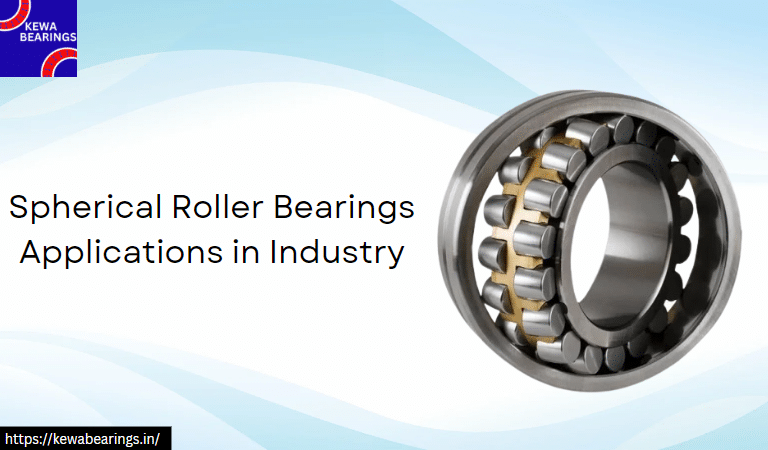Spherical ball bearings have been known for their vibration and noise tolerance. No matter how harsh the environment, spherical roller bearings will function smoothly without even asking for much maintenance. When the rollers and raceways undergo dimensional stabilization and heat treatment, these bearings can effectively operate in temperatures reaching up to 500°F. Sounds amazing, right? In this blog post, Kewa Bearings will introduce you to the applications of these very bearings in the industry.
Factors Affecting the Application of Spherical Roller Bearings
It’s important to consider these factors when selecting a spherical roller bearing for an application. Proper load, operating temperature, and speed conditions are crucial for ensuring optimal performance and longevity of the bearing. Factors determining the effectiveness of spherical roller bearings in a specific application include:
- Minimum Load: The bearing requires a minimum axial load to operate effectively at high speeds with stable acceleration and deceleration. This load prevents damage to the cage caused by inertial forces and excessive friction. Quality lubrication can help reduce the required minimum load.
- Operating Temperature: The range of ambient temperatures in which the bearing functions reliably affects its performance. In low-temperature environments, the viscosity of the lubricant increases, necessitating a higher minimum load. Spherical ball bearings that undergo heat treatment processes can handle particularly high operating temperatures.
- Reference Speed: The rotational speed at which the heat generated from rotation equals the heat dissipated from the lubricant and bearing geometry is known as the reference speed. It represents the optimal speed for efficient bearing operation.
- Limiting Speed: The highest RPM (rotations per minute) at which the bearing is designed to operate is known as the limiting speed. Several factors influence this speed, including the strength of the bearing cage, the quality of lubrication, the centrifugal and gyratory forces acting on the bearing, the precision of manufacturing, and the properties of the lubricant.
- Load Capacity: The load capacity of a bearing determines its ability to withstand applied loads without failure. It is influenced by the design, material, and construction of the bearing, as well as the lubrication used.
- Misalignment Compensation: Spherical roller bearings are well-suited for applications where housing alignment is challenging or shaft deflection is expected. Their design allows for some degree of misalignment compensation, ensuring proper functioning even in less-than-ideal conditions.
- Durability and Service Life: Spherical roller bearings are manufactured to have a long service life, with integral seals providing additional protection against contamination and extending their durability.
- Application-Specific Considerations: Different industries and applications have unique requirements. Spherical roller bearings find applications in gearboxes, casters, railway vehicles, mining aggregate conveyors, industrial fans, and rod mills. Considering specific application factors such as load type, speed, environmental conditions, and operating requirements is crucial for selecting the right bearing.
So, the effectiveness of a spherical roller bearing depends on factors such as the minimum load, operating temperature, reference speed, limiting speed, load capacity, misalignment compensation, durability, and application-specific considerations. These factors collectively determine the bearing’s performance, reliability, and service life in a given application. Proper selection and maintenance of spherical roller bearings are essential to ensure optimal functionality and longevity.
Notable Kewa’s Spherical Ball Bearings – Applications
Spherical roller bearings exhibit limited diversity, primarily differing in the design of the inner ring, rollers, and bearing case to suit specific applications. Let’s explore some notable variations and considerations related to Kewa’s spherical roller bearings:
Why the Double Row Roller bearing is used?
Double-row roller bearings are used in various applications due to their unique design and advantageous characteristics. But there’s more to it.
- Increased Load Capacity: Double-row roller bearings can accommodate higher radial and axial loads compared to single-row bearings. The presence of two rows of rollers distributes the load more effectively, resulting in enhanced load-carrying capacity. This makes double-row roller bearings suitable for applications that involve heavy loads or variable load directions.
- Improved Rigidity and Stability: The double-row configuration enhances the rigidity and stability of the bearing. The arrangement of two rows of rollers with a shared outer ring and two separate inner rings provides better support and prevents excessive deflection or misalignment. This makes double-row roller bearings more resistant to deformations and enables them to maintain accurate alignment, even under demanding conditions.
- Angular Misalignment Compensation: Double-row roller bearings are designed to compensate for angular misalignment. They can accommodate slight angular deviations between the shaft and Bearing housing, allowing for easier installation and alignment. This feature is particularly beneficial in applications where precise alignment is challenging or subject to variations during operation.
- Space Optimization: Double-row roller bearings offer a compact and space-saving solution. By incorporating two rows of rollers within a single-bearing unit, they can handle higher loads while occupying a smaller footprint compared to using multiple single-row bearings. This is advantageous in applications with limited space or where a compact design is desired.
- Versatile Applications: Double-row roller bearings find utility in various industries and equipment. They are commonly used in machinery such as machine tools, gearboxes, conveyor systems, and automotive applications. Their versatility allows them to accommodate diverse load types, speeds, and operating conditions.
So, double row spherical roller bearings are preferred in many applications due to their increased load capacity, improved rigidity and stability, angular misalignment compensation, space optimization, and versatility. These bearings provide reliable performance, withstand heavy loads, and maintain alignment, making them suitable for demanding industrial environments where precise load distribution and durability are crucial.
Used in Harsh Environments
Spherical ball bearings can be sealed to protect against contamination in demanding operating conditions. These sealed bearings are particularly suitable for environments exposed to dirt, debris, liquids, or extreme temperatures. Sealed bearings typically require minimal maintenance and do not usually require relubrication throughout their lifespan if they operate below 160°F, have a stationary outer ring, and do not exceed 50% of the limiting RPM. In case additional lubrication is required, sealed bearings are equipped with designated holes in the exterior raceway, which can also serve to flush out contaminants. However, it’s important to note that sealed bearings may have speed and temperature limitations compared to open bearings.
For Vibration and Shock Resistance
Spherical roller bearings are highly valued for their ability to self-align under heavy loads. To support this characteristic, these bearings incorporate a hardened guide ring centered in the outer raceway, which contains the robust bearing cage. The rollers themselves are often reinforced to withstand the dynamic accelerations, eccentricities, and linear forces they may experience during operation. Window-type cages are commonly used in spherical ball bearings to provide additional stability and durability.
Why the Barrel Roller Bearing bearing is used?
Barrel roller bearings represent a unique subtype of self-aligning bearings. Unlike traditional spherical roller bearings, these are self aligning roller bearing. They utilize only one row of rolling elements, known as barrel rollers. These rollers have a more bulbous shape compared to cylindrical rollers found in other spherical designs, hence the name “barrel rollers.” The inner raceway is specifically machined to accommodate this distinctive roller profile and includes flanges to contain the internal bearing components. Barrel roller bearings excel at handling very high radial loads; however, their capacity for axial loads is typically limited.
Application-Specific Considerations
Spherical ball bearings find utility in a range of industries and applications. They are commonly employed in gearboxes, casters, railway vehicles, mining aggregate conveyors, industrial fans, and rod mills. When selecting spherical roller bearings for a specific application, several factors should be taken into account. These factors include the type and magnitude of the load, rotational speed requirements, environmental conditions, and specific operational needs. Proper consideration of these factors ensures optimal performance and longevity of the bearings.
While the diversity of our spherical roller bearings may seem relatively limited, we offer specific variations tailored to various applications. Sealed bearings provide protection against contaminants in harsh environments, while their maintenance requirements are minimal. Spherical ball bearings exhibit excellent self-aligning properties under heavy loads, thanks to hardened guide rings and reinforced rollers. Barrel roller bearings stand out with their unique single-row design, ideal for high radial loads but with limited axial load capacities. Selecting the appropriate type of spherical roller bearing based on application-specific considerations is crucial for achieving optimal performance and reliability.
Get a quote for your next spherical roller bearing consignment at https://kewabearings.in/contact-us/.

